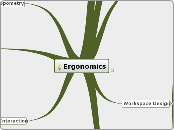Ergonomics
Books
Bodyspace - Anthropometry, Ergonomics and the Design of Work
Stephen Pheasant & Christine M. Haslegrave
Evaluation of Human Work
Wilson & Corlett
General Links
Lots more found in Rachels course booklet, page 24
Compile a list of references providing techniques and standards for physical ergonomics in the context of interactive devices & workplaces.
If system is affected = Reduction in task quality, efficiency, increased dev costs & training
If user is affected = user costs; well-being, effectiveness & satisfaction
Risk & Risk Assessment
Workspace Design
Defining the target population
The Limiting User
Not average User
95th percentile
Other users: maintainers, cleaners, assemblers etc
Users may change
temporarily
fatigue
permanently
growth
training
aging
Upper Limb Disorders
RSI / WRULD / CTD
Force
Anthropmetric fit
Repitition
Posture
Behavioural
Examples: Data input operator with a deadline may ignore wrist discomfort
Procrustean Approach to design states that Humans are very good at adapting to their environment
Hexagon Model - Benedyk, Woodcock and Harder
operator
workstation
workplace
work setting
external factors
Applying Physical Ergonomics
Stage 1 - Identify Users
Stage 2 - Identify Tasks
Stage 3 - Tasks -> Sub-tasks -> Arrange in Order -> split into Cognitive & Manual tasks
Stage 4 - Identify Limiting Users & their needs
Stage 5 - Take each design feature & consider it against each level of the Hexagon model
Stage 6 - Identify priorities
Anthropometry
Static data collection
Dynamic data collection
fitting trials
photographic analysis
Task Analysis
Human-Machine Interaction
Diverse environments
Physical interaction Paradigms
Gesture
Touch
Speech
Direct Sensors
Ubiquitous Computing
Clothing / Fabrics
